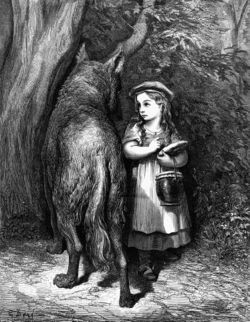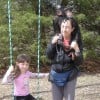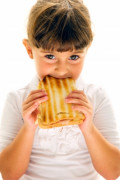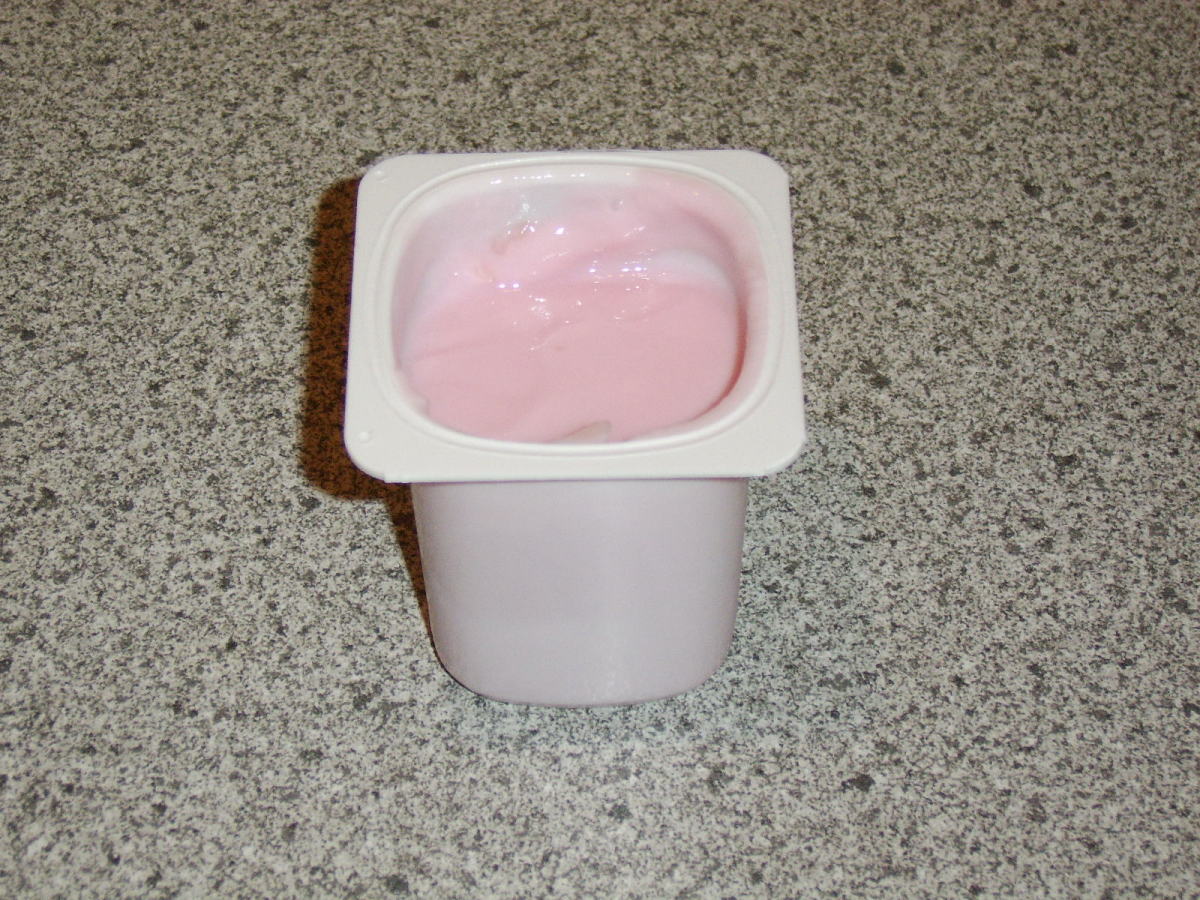What is Food?
Ilustration of Little Red Riding Hood by Gustave Dore

When I was about four years old, my favorite bedtime story was "Little Red Riding Hood." I never tired of hearing it. It was a scary story that involved an old woman and a little girl being devoured by a wolf and that ended with the death of the wolf. It was not the same story you may be reading to your child today.
One evening, after my father had told me the story yet again, I put on my most grown up tone and said: "But that's silly. Little girls aren't food."
"They are to a wolf!" my father replied.
I remember feeling really shocked. That thought had never occurred to me. It's all in the point of view.
So, what exactly is food? The answer depends on who you are.
IN DEFENSE OF FOOD by Michael Pollan
According to Michael Pollan, author of In Defense of Food, knowing what substances to eat and which to avoid is something we learn from our culture. The rules of what is proper food were passed down from mother to daughter, from parent to child, for generations without much controversy. But the past century saw the rise of nutritionism, and ordinary people have ceded the decision of what is good for us to scientists, dieticians and the food processing industry. People gave up their common sense understanding of food, replacing it with "nutrients" which are substances that nobody can see, feel or taste, and that only scientists can identify and catalogue. This was a bad move that brought about food fads, the latest of which was the lipid hypothesis, which caused untold damage to entire generations of people who, by removing dietary fat from their food, became ever more obese, and succumbed to heart disease and diabetes.
What does Pollan advise us to do? Eat food, not nutrients. And what exactly is food? Well, there's a whole list of rules that he suggest we follow in order to identify "real" food.
Hey, I used to have a list of rules, too!
When I was a little girl, I was a picky eater. I wouldn't eat just anything, and how foods were presented to me had a lot to do with which ones I would try. I eventually developed some rules that I lived by, as far as food was concerned:
- A food had to look like the animal or plant it was derived from. Chicken had to look like the recognizable parts of a chicken. Beef had to be red and marbled, not ground up. Fruit had better look like fruit, not sauce. Vegetables, to be tolerated, had to look like something taken right off the stalk, as in fresh peas in a pod.
- A food had to taste primarily like itself. I didn't like meat that was sweet or sour or peppery or salty. I didn't like fruit covered with chocolate. I didn't like vegetables smothered in cheese. I didn't like combinations. Everything had to be pure and unadulterated.
- There were exceptions for foods whose composition was beyond me: bread, cake, cookies, marzipan, halvah, humus, falafel, hot dogs, chocolate, Coca-Cola. These foods didn't seem ever to have come from a plant or animal, so I just accepted them as if they were elementary and indivisible wholes. However, try to put humus on my falafel and you'd ruin it!
- A food should not taste, look, or smell like something that someone has regurgitated. (Lasagna and most casseroles were right out.)
- When sitting together on the same plate, different foods should not touch.
My parents used to poke fun at my self-imposed dietary restrictions. "Don't you know that all the food you eat gets mixed together in your stomach after you eat it?" they would ask.
"I don't want to think about that," I'd answer. "It's disgusting."
The rules changed over time. As a toddler I didn't have them. I ate mashed carrots and meat balls and all sorts of pulverized and mixed food. I think I developed the rules as a pre-teen, in part as a defense against having "healthy foods" hidden inside my regular fare. At one point it got so bad, I wouldn't even eat a sandwich, anymore, because I didn't want my meat and bread touching.
Eventually, I outgrew those idiosyncracies, although it took time. I was still holding on to the last vestiges in my twenties. I took longer than most to grow up. By my thirties I began to open up to new foods in new combinations and to appreciate foreign cuisines. It was also in my thirties that I began to put on weight.
Were the self-imposed rules completely random and unmotivated? Or was part of them inspired by some kind of ancestral memory concerning what real food is like?
I'm not sure. But oddly enough, my daughter has independently come up with the same "no touching rule." By the time she came into this world, I had long given that up, so she didn't get it from me. But she won't eat her chicken if the sweet potato accidentally rubs against it. And she prefers to have different plates for different foods and a separate spoon or fork for every dish. Is it complete chance that made her come up with these preferences? Or are we all programmed by nature to want to eat our food unadulterated? Is this a protective mechanism that enculturation robs us of, once we become part of the fabric of society?
Michael Pollan's rules for what we should eat go something like this:
- Eat food. Not too much. Mostly plants.
- Avoid products that contain ingredients thate are: (a)unfamiliar (b)unpronounceable (c) more than five in number or (d) high-fructose corn syrup
- Avoid products that make health claims
- shop the edges of the supermarket and keep out of the middle area (where the processed foods are)
- Get out of the supermarket whenever possible.
I like most of Michael Pollan's rules, partly because they're so similar to the rules I used to have. I mean, look at his rule #2: It's a lot like my rule#1. Nothing weird. No strange ingredients. Just the stuff we're used to. In a way, the rules are the same xenophobic instincts we all fight so hard to get rid of as we become civilized: don't accept something new and strange when you have no idea what it contains. It's the same reason my chimpanzee son, Bow, won't eat a new food, without first making me try it.
But Pollan's rule #1 has me puzzled. Why mostly plants? And what does "mostly" mean? By volume? By number of items? By caloric content? It comes out differently depending on which way you measure it. If I have a dinner menu of a small cornish hen, asparagus, a sweet potato and a whole peach for dessert, have I eaten mostly plants? Or mostly animals? Of the four items listed three are plants and one is an animal. However, the animal contains the majority of the calories. And yet, in his anti-nutritionism, Pollan urges us to count foods, not nutrients. If we count foods, it comes out mostly plants!
The Vegan Bias
I recommended In Defense of Food to a friend, because I thought Pollan had so many important points to make, and I agreed with his overall method of reasoning. But my friend was turned off by the words "mostly plants." We are neither of us vegetarian, and my friend detected a sort of anti-meat bias in what Pollan was saying.
It's true. There is that bias. Pollan, like many liberal minded people, has moral qualms about meat-eating, and this spills over into his nutritional recommendations. But if you read what he says, rather than what he recommends, then there is nothing in this book to suggest that eating meat is bad for us. I'm going to quote a few passages below:
"... Meat, which humans have been going to heroic lengths to obtain and have been relishing for a very long time, is nutritious food, supplying all the essential amino acids as well as many vitamins and minerals, and I haven't found a compelling health reason to exclude it from the diet...
What exactly it is in meat that we need to worry about is uclear.... It could be simply that eating lots of it pushes plants out of the diet." In Defense of Food, pp. 165-166
I think that's what it is: we have to eat plants as well as animals, and when we eat only meat, we miss out on fiber, water and other important nutrients found in plants. So take Pollan's rule literally (rather than the way he intended it), by counting foods, not nutrients. Eat more plants than meat per meal, but get most of your calories from meat. This is easy to do, because meat is a calorie dense food, while vegetables are poor sources of calories per volume. Eat one steak, but lots of radishes and lettuce and tomatoes and peppers. Eat one chicken but lots of asparagus shoots and cabbage and broccoli. Eat one fish, but lots of brussels sprouts and peas and carrots. Got it?
The Circle of Life
What about moral qualms concerning eating meat? I think they stem from the fact that we have been eating processed food for so long, that we've forgotten what food really is. People who live on Cheerios and Wonder Bread and hot dogs might really have the impression that food is a completely benign substance that we manufacture from inert materials in no way related to plants and other animals. One way vegetarians gain converts is by pointing out to an innocent child that the steak on his plate used to be a cow. This form of recruitment could never happen with children who grew up on the farm or lived as hunter-gatherers. Meat comes from other animals. Where else could it come from? Every food we eat means we have snuffed out the life of another living being, plant or animal. Life feeds on life. It's the circle of life, and even Disney knows about it.
The Predator/Prey Relationship
We don't like to think of ourselves as predators, and that is part of the bias against meat.
The prejudice against predators dates back to the days when we were both predator and prey. Nobody wants to be eaten by a wolf, and so wolves have been vilified in our literature for generations, in stories like the one about Little Red Riding Hood. But did you know that without predators, the prey cannot flourish? Predators keep deer and antelope and gazelle in top health, weeding out the weak and diseased and making sure that populations do not proliferate beyond what the ecosystem can bear.
The problem with the way we raise meat today is that we don't act like good predators. We don't make sure our animals stay healthy by culling out the weak and diseased. Instead, we give them antibiotics.
A good shepherd or herdsman would never do that. Our health depends on the health of the animals we feed on. The average wolf, coyote, mountain lion or leopard does a better job of overseeing his food source than we do.
Our problem is that we are not predatory enough.
Conclusion: Food is Life
So what is food for a human being? It is either an animal or plant whose life has been cut short so that we may live another day.
We are not plants. We are incapable of photosynthesis ourselves. We are not herbivores, so we don't graze on the grasses of the field all day long. We are omnivores. We eat plants and we eat other animals, and we need both in order to thrive. We depend on the cycle of life, like everybody else on this planet. Like other predators, we are responsible for the health of the animals on which we prey. Like other plant eaters, we rely on the minerals in the soil in which our food grows. Like everybody else in this world, we are part of the cycle of life, and we cannot expect to take without giving.
What should you do before taking a bite? Look at what you're eating, sniff it, feel its texture. If it bears no resemblance to any animal or plant you've ever seen, it probably isn't food.
(c) 2008 Aya Katz








